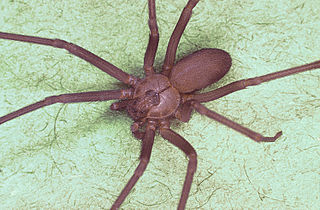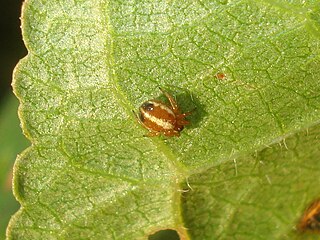
Huntsman spiders, members of the family Sparassidae, catch their prey by hunting rather than in webs. They are also called giant crab spiders because of their size and appearance. Larger species sometimes are referred to as wood spiders, because of their preference for woody places. In southern Africa the genus Palystes are known as rain spiders or lizard-eating spiders. Commonly, they are confused with baboon spiders from the Mygalomorphae infraorder, which are not closely related.

Spitting spiders are a family of araneomorph spiders, the family Scytodidae, first described by John Blackwall in 1864. It contains over 250 species in five genera, of which Scytodes is the best-known.

Ctenizidae is a small family of mygalomorph spiders that construct burrows with a cork-like trapdoor made of soil, vegetation, and silk. They may be called trapdoor spiders, as are other, similar species, such as those of the families Liphistiidae, Barychelidae, and Cyrtaucheniidae, and some species in the Idiopidae and Nemesiidae. The name comes from the distinctive behavior of the spiders to construct trapdoors, and ambush prey from beneath them.

Sicariidae is a family of six-eyed venomous spiders known for their potentially necrotic bites. The family consists of three genera and about 160 species. Well known spiders in this family include the brown recluse spider and the six-eyed sand spider.

The Pholcidae are a family of araneomorph spiders. The family contains more than 1,800 individual species of pholcids, including those commonly known as cellar spider, daddy long-legs spider, carpenter spider, daddy long-legger, vibrating spider, gyrating spider, long daddy, and angel spider. The family, first described by Carl Ludwig Koch in 1850, is divided into 94 genera.

Sennar is one of the 18 wilayat or states of Sudan. It has an area of 37,844 km2 (14,612 sq mi) and had a population of approximately 1,918,692 in 2018.

The diving bell spider or water spider is the only species of spider known to live almost entirely under water. It is the only member of the genus Argyroneta. When out of the water, the spider ranges in colour from mid to dark brown, although the hairs on the abdomen give it a dark grey, velvet-like appearance. It is native to freshwater habitats in Europe and Asia.
Eugeni Leonidovitsch Redkine, known as Eugeni Redkine, is a former Russian biathlete. He won a surprising gold medal over 20 kilometres ahead of Mark Kirchner and Mikael Löfgren at the 1992 Winter Olympics.

Barychelidae, also known as brushed trapdoor spiders, is a spider family with about 300 species in 39 genera.

The spider genus Cabello consists of only one species, Cabello eugeni, found in Venezuela. It is a small yellow-white spider, with females 2 mm long, and males 1.6 mm. The eye region is reddish with a dusky median longitudinal band, the sternum whitish, with grey sides. The yellow-white legs have scattered black spots on the anterior face. On the abdomen there are scattered white spots.

The book Svenska Spindlar or Aranei Svecici is one of the major works of the Swedish arachnologist and entomologist Carl Alexander Clerck and was first published in Stockholm in the year 1757. It was the first comprehensive book on the spiders of Sweden and one of the first regional monographs of a group of animals worldwide. The full title of the work is Svenska Spindlar uti sina hufvud-slägter indelte samt under några och sextio särskildte arter beskrefne och med illuminerade figurer uplyste – Aranei Svecici, descriptionibus et figuris æneis illustrati, ad genera subalterna redacti, speciebus ultra LX determinati, and included 162 pages of text and six colour plates. It was published in Swedish, with a Latin translation printed in a slightly smaller font below the Swedish text.
Eugeni Valderrama Domènech, simply known as Eugeni, is a Spanish footballer who plays as a central midfielder for Ibiza.

Hypsosinga is a genus of orb-weaver spiders first described by Anton Ausserer in 1871. The genus name is derived from the Greek "hypso", meaning "high", referring to the higher clypeus than those of the genus Singa.

Apache SINGA is an Apache top-level project for developing an open source machine learning library. It provides a flexible architecture for scalable distributed training, is extensible to run over a wide range of hardware, and has a focus on health-care applications.

Madeline Singas is an American attorney and judge who serves as an associate judge of the New York Court of Appeals since 2021.
Philodromus spectabilis is a species of running crab spider in the family Philodromidae. It is found in the USA and Canada.
Centromerus cornupalpis is a species of sheetweb spider in the family Linyphiidae. It is found in the USA and Canada. This species exhibits sexual dimorphism. Males are identifiable by the shape of the cymbium, radix, and possession of a long proximo-dorsal horn on the paracymbium. Females exhibit a narrow, smooth constricted scape that originates anteriorly to the postero-lateral corners of the epigynum.

Singa, also called striped orb-weavers, is a genus of orb-weaver spiders first described by C. L. Koch in 1836. They are small for orb-weavers, reaching 6 millimetres (0.24 in) or less in body length, excluding the legs.
Singa keyserlingi is a species of orb weaver in the spider family Araneidae. It is found in the United States and Canada.














